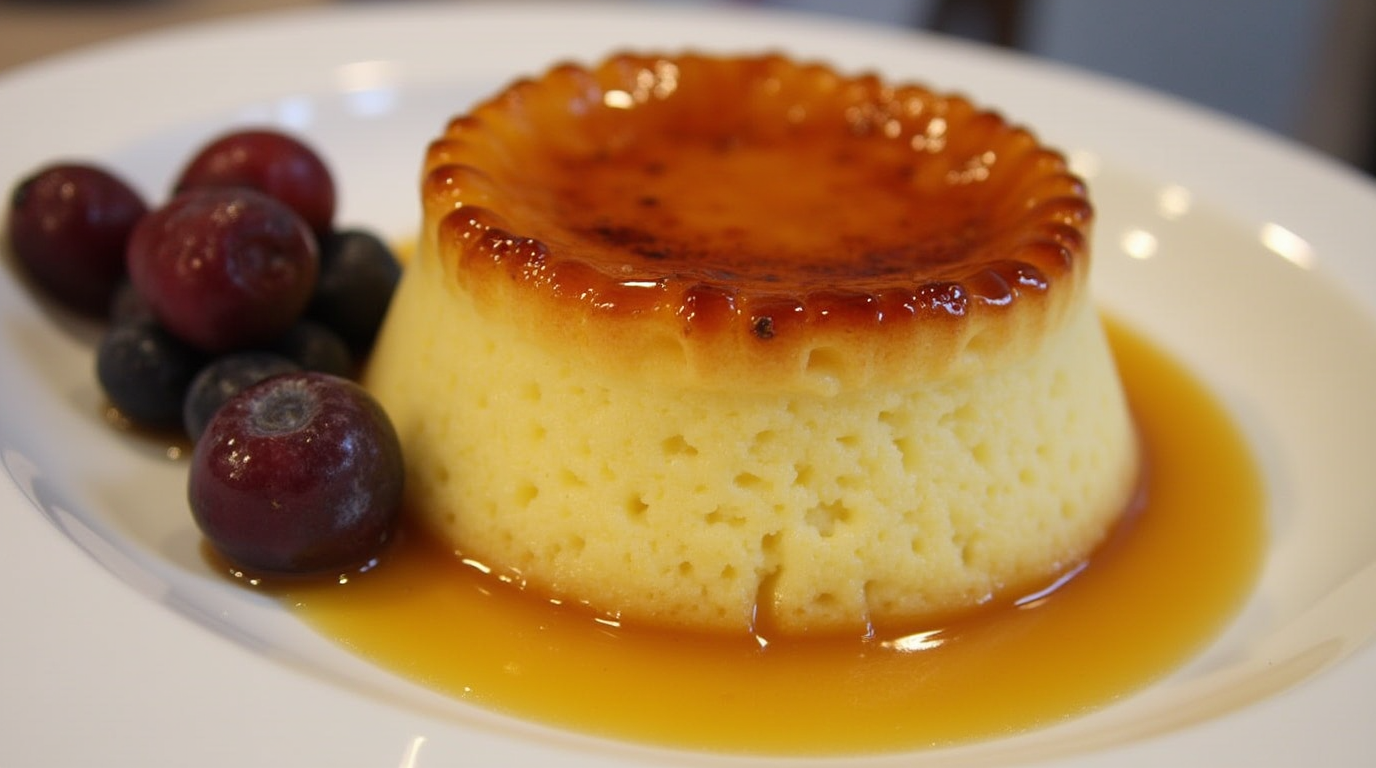Have you ever cracked into that glossy, caramelized sugar crust, only to scoop up a velvety spoonful of creamy custard beneath? If that description has your taste buds tingling, then you’re in for a treat! This article dives into the question: What does crème brûlée taste like? We’ll chat about its sweet, smooth, and utterly delightful flavors, explore the textures, and even compare it to other desserts you might know. Whether you’re a dessert connoisseur or just dessert-curious, there’s something here for everyone. Let’s dig in!
An Introduction to Crème Brûlée
What is Crème Brûlée?
Crème brûlée is a fancy French dessert that’s simpler than it sounds. At its heart, it’s a custard base made with cream, egg yolks, sugar, and usually a touch of vanilla. The star of the show, though? That thin, torched sugar topping. It’s sweet, it’s crunchy, and it’s irresistible. Imagine cracking through a caramelized shell to reach the creamy goodness below—it’s like a dessert version of breaking into a treasure chest!
The History Behind the Dessert
Though we think of crème brûlée as quintessentially French, its origins are a bit of a mystery. Some say it popped up in England as “burnt cream,” while others credit Catalonia’s “crema catalana.” Wherever it came from, it hit its stride in French kitchens during the late 17th century. Today, it’s a dessert that screams sophistication but is loved by all—whether you’re at a fine dining restaurant or making it at home.
Stay tuned because we’ll be breaking down exactly what crème brûlée tastes like next!

Key Characteristics of Crème Brûlée’s Taste
A Symphony of Flavors: Sweetness and Caramelization
So, what does crème brûlée taste like? At first bite, you’re greeted by the unmistakable crunch of caramelized sugar. It’s sweet, sure, but not overwhelmingly so. That golden-brown layer brings a toasty, almost nutty flavor that’s hard to resist. The caramelization adds depth, balancing the sweetness with a subtle bitterness—like the perfect sip of caramelized coffee.
The Custard Core: Rich, Creamy, and Velvety
Beneath the sugar shell lies the custard, which is where the magic happens. It’s creamy, smooth, and rich—almost like melted ice cream but better. The vanilla flavor typically shines here, offering a soft, fragrant sweetness that lingers on your tongue. The custard itself is light yet decadent, making it a dessert you’ll want to savor slowly.
How the Torched Sugar Enhances Flavor
Let’s face it—the sugar crust is what makes crème brûlée iconic. It’s not just a textural contrast; it’s a flavor enhancer too. When the sugar is torched, it caramelizes into a brittle topping that’s both sweet and smoky. This interplay of textures and tastes creates a perfectly balanced dessert that keeps you coming back for more. In short, the combination of creamy custard and crunchy sugar defines what crème brûlée tastes like—a blend of indulgence and elegance.
Texture: A Balance of Crunch and Creaminess
The Crisp Caramelized Top
Cracking into the caramelized sugar top is one of the most satisfying parts of eating crème brûlée. It’s like breaking into the crust of a crème caramel but with a lot more drama. The sugar crust is thin but packs a loud crunch, making it the perfect counterpoint to the smooth custard beneath.
Silky Custard Consistency
Once you break through that sugar, the custard greets your spoon with silky, velvety goodness. It’s soft without being runny, firm without being heavy. This balance makes crème brûlée a textural masterpiece. And that’s a big reason why so many people wonder, “What does crème brûlée taste like?”—because the experience of eating it is as much about texture as it is about flavor.
From the first crack to the last spoonful, crème brûlée keeps your palate entertained with its unique contrast of textures. It’s no wonder this dessert has earned its spot as a classic!
Variations in Crème Brûlée Flavors
Traditional Vanilla vs. Modern Twists
When people ask, “What does crème brûlée taste like?”, they’re usually thinking of the classic vanilla version. It’s the gold standard, with its rich, smooth custard infused with pure vanilla bean. But, oh boy, the modern takes are a whole new ball game! From coffee-infused brûlées to matcha, lavender, or even pumpkin spice, there’s a flavor for every palate. These twists add fun layers of taste while keeping the dessert’s iconic creamy texture intact.
Popular Flavor Variations: Chocolate, Coffee, and Citrus
Chocolate crème brûlée? It’s as indulgent as it sounds, combining the smooth custard with rich cocoa notes. Coffee lovers, don’t fret—espresso or mocha variations give the dessert a bold kick. And if you prefer something lighter, citrus flavors like lemon or orange zest create a refreshing balance to the dessert’s sweetness. Want to experiment? Try a seasonal twist, like peppermint for the holidays!
For more creative dessert ideas, check out Perfect Crème Brûlée Secrets.

How Crème Brûlée Compares to Similar Desserts
Crème Brûlée vs. Flan: What’s the Difference?
Flan and crème brûlée might seem like siblings in the dessert world, but their taste and texture are quite different. While flan is lighter and jiggly, crème brûlée boasts a firmer, silkier custard with a satisfying crunch on top. Wondering “What does crème brûlée taste like?” Think buttery richness with a toasted sweetness, unlike flan’s more straightforward caramel flavor.
Comparing Crème Brûlée with Custards and Puddings
Custards and puddings share some similarities with crème brûlée, but they lack the signature torched sugar crust. A traditional custard might feel a little plainer, while pudding is often less rich and creamy. Crème brûlée takes the crown when it comes to sophistication and sensory delight—offering layers of taste and texture that set it apart.
For other custard-inspired desserts, you might enjoy What’s the Difference Between Crème Brûlée and Custard?.
Let me know if you’d like me to continue with the next parts!
The Experience of Eating Crème Brûlée
The First Crack: Breaking the Sugar Shell
Eating crème brûlée is as much about the experience as it is about the flavor. Imagine tapping your spoon against that golden caramelized crust—it shatters like glass, revealing the creamy custard underneath. This dramatic moment is what dessert lovers live for! The sound, the crunch, and the contrast between the brittle sugar and the smooth custard make the first bite unforgettable. It’s no wonder people keep asking, “What does crème brûlée taste like?”—it’s a multi-sensory treat.
Flavor Transitions: A Journey from Crunch to Cream
The magic doesn’t stop at the crunch. As you scoop up a bite, the sweetness of the sugar fades into the rich, silky custard. The textures meld beautifully, giving you that perfect balance of brittle and creamy. Each spoonful is a mix of smoky caramel, fragrant vanilla, and buttery richness that lingers on your taste buds. It’s the kind of dessert where every bite feels like a tiny celebration.
Want to try something similar? Check out Perfect Crème Brûlée Secrets for tips on making this iconic dessert.
Tips for Enjoying Crème Brûlée
Pairing Suggestions: Wine, Coffee, and More
Crème brûlée might be a dessert on its own, but pair it with the right drink, and you’ve got yourself an even better experience. A glass of Sauternes or a light Moscato wine complements the dessert’s creamy sweetness. Prefer something non-alcoholic? A cup of rich espresso or cappuccino balances the sugar’s caramel notes perfectly. For something unique, try it with a chai latte—the spices pair surprisingly well with the custard’s vanilla base.
Serving and Presentation Tips
Want to impress your guests? Serve crème brûlée in individual ramekins for a touch of elegance. Add fresh berries like raspberries or blackberries on top for a pop of color and a tangy contrast to the sweetness. If you’re hosting during the holidays, sprinkle a bit of cinnamon or nutmeg on the sugar before caramelizing it for a seasonal twist.
For more hosting ideas and dessert recipes, check out What’s the Difference Between Crème Brûlée and Custard?.
Let me know if you’d like me to continue with Part 8 and the FAQ section!
Crème Brûlée FAQs
Is Crème Brûlée Too Sweet?
Not at all! What does crème brûlée taste like? It’s sweet, yes, but it’s more about balance. The caramelized sugar layer brings a toasty sweetness, while the creamy custard keeps things smooth and mellow. It’s rich without being overpowering, making it a dessert that satisfies without overwhelming your palate.
How is Crème Brûlée Made?
Making crème brûlée might sound intimidating, but it’s simpler than you think. The custard base is made by whisking cream, egg yolks, sugar, and vanilla together. It’s baked gently in a water bath to ensure a silky texture. Once chilled, sugar is sprinkled on top and torched until it caramelizes into that signature crispy crust. For tips on perfecting your technique, you can check out Perfect Crème Brûlée Secrets.
Can You Customize the Recipe?
Absolutely! One of the best things about crème brûlée is its versatility. You can swap vanilla for other flavors like chocolate, coffee, or even matcha. Seasonal variations like pumpkin spice crème brûlée are a hit during the fall.
If you’re feeling adventurous, why not try experimenting with your favorite flavors? You’ll discover new ways to answer the age-old question: “What does crème brûlée taste like?”
The Popularity of Crème Brûlée Around the World
A Dessert for All Occasions
Crème brûlée is loved worldwide, and for good reason. It’s a dessert that feels fancy but is simple enough to enjoy on a casual evening. From fine dining establishments to cozy kitchens, it’s a treat that works for birthdays, holidays, or just because.
Global Interpretations and Popularity
Though it’s rooted in French cuisine, crème brûlée has made its way into menus across the globe. You’ll find unique versions in Asia featuring flavors like green tea or black sesame, while Latin American chefs experiment with dulce de leche twists. Its universal appeal lies in its ability to adapt while keeping the core experience of cracking into that caramelized crust intact.
Craving more dessert inspiration? Check out Perfect Crème Brûlée Secrets for new ideas and variations.
Let me know if you’d like to proceed with Part 10 and finalize the article!

